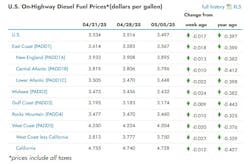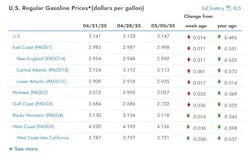Diesel prices continue to decline nationwide as gasoline prices edge up amid economic concerns
Key takeaways:
- Diesel prices have dropped to $3.497, while gasoline prices increased to $3.147.
- Diesel prices fell most in the Midwest at $3.432, while gasoline rose significantly in the Gulf Coast to $2.722.
- Economic concerns and higher OPEC+ output are driving down crude oil prices, affecting diesel and gasoline rates differently.
While gasoline prices rose across the nation this week, diesel prices continued to drop. The national average on-highway diesel price dropped 2 cents to $3.497 according to data released by the U.S. Energy Information Administration on May 6. Gas prices rose 1 cent to $3.147.
What are the current diesel prices across the U.S?
Here are this week’s diesel price highlights from each region of the U.S.:
- Midwest: The biggest drop in diesel prices occurred in the Midwest, with 2 cents to $3.432.
- West Coast: On the West Coast, diesel prices dropped 2 cents to $4.204. Without including California, prices dropped 3 cents to $3.750.
- East Coast: On the East Coast, diesel prices dropped 2 cents to $3.567.
- Rocky Mountain: In the Rockies, diesel prices dropped 1 cent to $3.460.
- Gulf Coast: On the Gulf Coast, diesel prices dropped 1 cent to $3.174.
According to AAA Motor Club, the current national diesel price average is $3.540. This is 4 cents higher than EIA’s current estimate and 43 cents lower than this time last year.
See also: Diesel, gas prices continue to drop ahead of summer travel
What are the current gasoline prices across the U.S.?
The current national average on-highway gasoline price is $3.147, according to EIA, 1 cent higher than last week’s average.
Here are this week’s gasoline price highlights from each region of the U.S.:
- Gulf Coast: Gas prices in the Gulf Coast region rose the most, by 4 cents to $2.722.
- Midwest: The Midwest saw a 4-cent increase in gas prices to $3.027.
- East Coast: The price of gas on the East Coast rose by 1 cent to $2.998.
- Rocky Mountain: In the Rockies, gas prices dropped 2 cents to $3.118.
- West Coast: On the West Coast, gas prices dropped 4 cents to $4.156. Without including California, gas prices dropped 4 cents to $3.721.
According to AAA, the current national gasoline price average is $3.158. This is 1 cent higher than EIA’s current estimate and 49 cents lower than this time last year.
In a recent press release, AAA said, “Even though this is the time of year when we typically see seasonal increases and rising demand, the price of crude oil has been plunging. A couple of factors are at play: economic concerns and the decision by OPEC+ (the group of oil-producing countries) to increase output and add more oil to the market, despite tepid demand. The lower the price of oil, the less drivers pay at the pump.”
About the Author

Jenna Hume
Digital Editor
Digital Editor Jenna Hume joined FleetOwner in November of 2023 and previously worked as a writer in the gaming industry. She has a bachelor of fine arts degree in creative writing from Truman State University and a master of fine arts degree in writing from Lindenwood University. She is currently based in Missouri.


